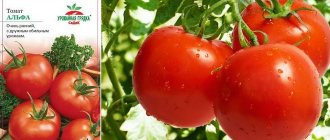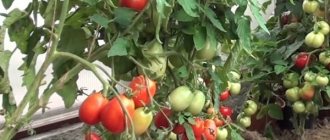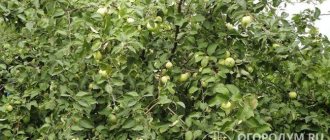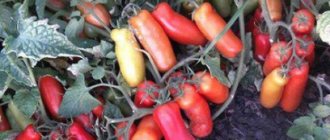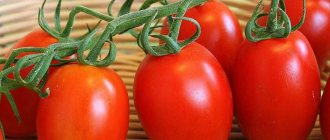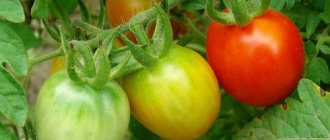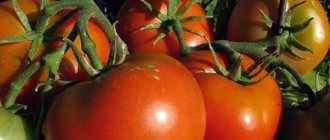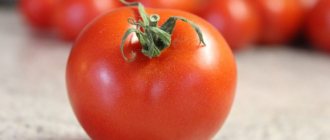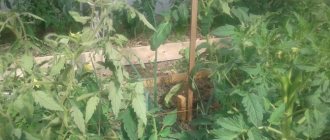Characteristics and description of the variety
Tomato belongs to the hybrid crops, the genes of which contain high resistance to diseases of the nightshade family. Recommended for cultivation in open ground and in greenhouse conditions.
Distinctive features
The type is determinant, the height depends on the place of growth: in open ground it reaches 70 cm, and in a greenhouse more than 1 m. The bush is spreading, branched, the leaves are dark green, the inflorescences are simple. Each branch bears 5–7 fruits.
The ripening period is early; 95–100 days pass from the moment the seeds are planted to full ripeness. It takes root well both in open ground and in greenhouse conditions.
The hybrid is drought-resistant and does not require watering. Productivity is high, from 1 sq. m, up to 15 kg of selected vegetables are collected, provided that 4–5 seedlings are planted per 1 sq. m.
It is highly resistant to tomato diseases and pests. Not susceptible to fungal infections.
Fruit characteristics
The average weight of the fruit is 230–250 g, the shape is flat-round, the color is deep red. Despite the fact that Juggler f1 is a hybrid and not a variety, the taste of the fruit is rich, sweet, with a clear sourness characteristic of tomatoes, the flesh is juicy. The skin is dense and does not crack during heat treatment - ripe vegetables are suitable for preservation. Hybrid tomatoes Juggler f1 retain their excellent taste in fresh dishes.
By processing vegetables, delicious juices, ketchups, adjika and pasta are obtained. Thanks to their dense pulp and durable peel, tomatoes are transported over long distances and stored for a long time without losing their taste or appearance.
The photo shows tomatoes Juggler f1.
Landing in the ground
Juggler tomatoes are grown in open areas. Under cover, plants produce higher yields. The variety tolerates temperature changes and changes in weather conditions.
Golden root (Rhodiola rosea): medicinal properties and contraindications, application
Tomatoes prefer areas with constant sunlight and light, fertile soil. The soil for the crop is prepared in the autumn. The beds are dug up and rotted manure or compost is added.
In the greenhouse, 12 cm of the top soil layer is completely replaced. You can fertilize the soil with superphosphate and potassium salt. Take 40 g of each substance per 1 square meter. m.
Juggler tomatoes are ready for planting if they have about 6 leaves and have reached a height of 25 cm. Leave 40 cm between the tomatoes in the garden. The plants are removed from the containers and placed in the holes. The roots need to be covered with soil and compacted. After planting, the tomatoes are watered with 5 liters of water.
How to grow seedlings
The hybrid can be grown in two ways: seedlings and without seedlings. When sowing seeds at home for seedlings, it is necessary to prepare the seed material.
Seed preparation
The seed material purchased from a specialized store is almost ready for planting: the manufacturer has already carried out disinfection and calibration. All that remains is to soak the seeds in a growth stimulator for 10 hours. This procedure will improve the germination percentage. The remedies are used not only by industrial production, but also by folk ones, and the latter are in no way inferior to biological stimulants.
Traditional methods include potato juice, aloe juice and melt water. Aloe juice additionally disinfects seed material, and potato juice enriches it with nutrients. Melt water is obtained from snow heated to room temperature.
Reference! Growth stimulants are organic substances that influence the growth and development of plants.
Preparing the container and soil
The soil for sowing seeds is prepared from a mixture of garden soil, humus and river sand in equal proportions. Disinfect the prepared soil in the oven at a temperature of 60 °C for 10 minutes or spill it with a hot solution of dark manganese. Disinfected soil will ensure healthy growth of young plants. You can also buy soil at the store. As a rule, purchased soil does not require disinfection or additional preparation.
Any container will do. You can plant both in a common and in a separate container. From the general container, a box is most often used, and plastic cups, paper honeycombs or peat pots are used as separate containers. When planting in separate containers, picking seedlings can be eliminated in the future.
Before sowing, the prepared containers are treated with a dark potassium permanganate solution for preventive purposes and small drainage holes are made at the bottom.
Sowing
The seeds are buried 1.5 cm, sprinkled with soil on top, lightly moistened with warm, settled water from a spray bottle and covered with film, artificially creating a greenhouse effect. The containers are left in a bright room at a temperature of +23–25 °C until germination.
Caring for seedlings
After sprouting, the containers are placed on the windowsill to provide the sprouts with sufficient light. If there is not enough daylight, the seedlings will stretch out and weaken, which will further retard their growth and development.
Reference! When daylight hours are short, additional lighting is installed using fluorescent lamps.
Water as the top layer of soil dries with warm, settled water from a shallow watering can or with a regular tablespoon. You cannot overwater the seedlings; the accumulation of excess moisture will cause rotting of the young roots. Also, with a large amount of moisture, the risk of developing a dangerous disease - blackleg - increases. The cause of blackleg is protobacteria of the genus Erwinia. The disease can destroy all plantings.
Reference! In the specialized literature, the term “blackleg” is not used, since it is the general name for a group of diseases with similar symptoms. Characterized by darkening of the stem at the very surface of the earth, it affects seedlings of vegetable and flower crops grown indoors or in greenhouses.
After watering, the soil is loosened to improve the air permeability of the soil. The flow of oxygen has a positive effect on the root system.
When two true leaves appear, pick them, placing them in separate containers. If the seedlings are left in a common container, then increase the distance between the seedlings, planting them no closer than 15 cm from each other.
Before transplanting into the ground, the bushes are hardened off in the open air, taking them outside for 40–50 minutes. Every day the stay time is increased by 30 minutes. Hardening is carried out for 10 days.
Canopus tomato
The name Canopus tomatoes are immediately associated with one of the brightest giant stars that sparkles in the southern hemisphere of the night sky. For novice gardeners and gardeners, this variety of tomatoes can be said to be a ray of light, because cultivating Canopus tomatoes does not require much effort and time, since the plant is classified as unpretentious.
Vegetable growers who have tried growing this crop note not only the ease of care, but also the excellent taste of the fruit. To grow plants of this variety, you only need systematic watering, sunlight and a little fertilizer. In this publication we will consider the characteristics and description of the Canopus tomato variety.
general characteristics
Canopus tomatoes grow up to 40-60 cm in height, have a simple inflorescence and medium-sized bright green leaves. Inflorescences begin to appear above 6-9 leaves with an interval of 2-3 leaves.
The shape of the fruit resembles a cylinder, they are quite large in size - from 150 to 400 g - and have a juicy, rich taste. Ripe fruits have a bright red color, which contrasts with the green tops and looks bright and appetizing.
Advantages of the variety
Advantages of vegetable crops:
- tomatoes grow quite large;
- the fruits are very juicy;
- the taste is universal and can be combined with almost all food products;
- tolerates both conservation and processing;
- easy care;
- high productivity;
- adapts to unfavorable environmental conditions.
Note! The variety is resistant to minor droughts
Another important advantage is resistance to various diseases. Particularly noted is endurance to diseases such as:
Particularly noted is endurance to diseases such as:
Another important advantage is resistance to various diseases. Particularly noted is endurance to diseases such as:
- Late blight. This disease can destroy entire fields of future crops. Signs of the disease are gray-brown spots on the foliage, similar to mold. Late blight spreads to both stems and fruits.
- Tobacco mosaic virus. This disease leaves yellow spots on leaves and fruits. Because of this, both the taste of the fruit and its appearance deteriorate.
- Bacterial spotting. Plants become covered with rust-like spots. Both the leaves and the fruits themselves are susceptible to attack.
Tobacco mosaic virus
By following simple rules for caring for plants of this variety, you can harvest a rich harvest of bright red tomatoes that will surprise you with their excellent taste.
How to plant and grow Canopus tomatoes
Unpretentious plants still need care. However, they do not require much attention, so there is no hassle with them. You can be surprised by the abundance of tomatoes if you follow just a few recommendations:
- Canopus will reward you with excellent taste and a large harvest, if you add a little fertilizer to the soil, it is better to choose store-bought mixtures that are ready for use;
- the soil can be lined with bird droppings or some other organic matter;
- organic substances perfectly stimulate the growth of stems and fruits, and also attract earthworms, which loosen the soil well;
- Tomato stems must be tied to pegs in a timely manner as the tops grow;
- When cultivating tomatoes in greenhouse conditions, removing side shoots will ensure an early harvest. In open areas of soil, pinching is not a necessary procedure.
Canopus is a tomato ideal for beginners and for people who want to get a rich harvest of tomatoes with excellent taste without wasting time and effort.
How to grow tomatoes
The seedlings are transplanted into the ground two months after sowing the seeds. By this time, at least four true leaves have formed on the bushes. The beds are chosen in a sunny place, protected from drafts.
Landing
The soil is prepared in advance : it is dug up and a full range of minerals is added. Make holes 15–20 cm deep and fill them with water.
Replant on a cloudy day or in the evening hours after sunset. This way the seedlings will take root and grow faster.
They are planted in the holes together with a lump of earth without disturbing the root system. After transplantation, the holes are compacted and watered with warm, settled water.
Further care for tomato Juggler f1
Regular watering is established as the seedlings take root in a new location. Water moderately, no more than twice a week. The peculiarity of this tomato is that it does not suffer from a long absence of watering, so it is not so bad not to water the plants as to flood them.
The root system suffers from excess moisture, and the seedlings begin to get sick. Water in the early morning or in the evening, but not in the scorching sun. To retain moisture in the beds, they are mulched with peat or straw.
Reference! Watering during the day can cause leaf burn.
After moistening, the soil is loosened and all weeds with roots are removed so that the nutrients are spent on the growth of seedlings and not on weeds. Many pests that are dangerous to tomatoes live in weeds.
Fertilizing is applied once every three weeks. During the season, seedlings are fertilized at least four times. The first fertilizing is applied two weeks after transplantation. Water with mullein infusion in a ratio of 1:15. The second is carried out at the time of flowering of the crop. They add a full range of minerals with a predominant content of phosphorus.
During the formation of ovaries, phosphorus and calcium are added, and at the time of fruiting, potassium salts are added to speed up the ripening of the fruit.
Features of cultivation and possible difficulties
The fruits of the Juggler hybrid are heavy; as they ripen, they can break the fruiting branches . Therefore, after transplantation, a support is installed next to each seedling, to which the branches are tied as they grow. The stem is also fixed, since it cannot withstand the weight of numerous fruit-bearing branches. The bush is formed into 3 stems, removing all other stepsons.
The lateral shoots of the stems thicken the plantings, so pinching is carried out regularly. The density of the bush can lead to the spread of fungal diseases.
Reference! The stepson is a side shoot that appears from the axils of the leaves and interferes with the full ripening of the fruit.
Diseases and pests
Summer residents report in their reviews that the vegetable crop practically does not get sick. This is a very convincing reason to grow a hybrid on your site. However, experienced gardeners do not forget about preventive measures, which include weeding, loosening and moderate watering. Treatment with Fitosporin not only protects plants from damage by fungal spores, but also improves immunity.
The hybrid is also immune from insect pests, so it is enough to plant sharp-smelling herbs between the tomato seedlings: calendula, mustard or marigolds and spray the young bushes with infusions of nettle, onion peel and plantain.
Crop rotation rules are important for healthy growth and development. If they are followed, the crop not only remains strong and healthy, but also produces tasty fruits. Good predecessors for tomatoes are cabbage, pumpkin, carrots, beets and green onions.
Features of cultivation
To obtain the maximum yield, seeds for seedlings are sown in the second half of April, but then the harvesting of fruits is postponed to July. Therefore, gardeners can independently choose a convenient date and start growing, for example, in early March. After 2 months, Juggler tomato seedlings can be transferred to a greenhouse or open ground.
Seedlings are grown in boxes, cassettes, peat pots or other containers. You need to make several drainage holes in them. Then you should prepare the soil. It can be composed of the same amount of garden soil and peat (with the addition of a few pinches of sand and wood ash) or based on the following components (equal ratio):
- leaf soil;
- compost;
- sand;
- humus.
The soil is first disinfected in a weak solution of potassium permanganate or frozen in the freezer a week before planting. The seeds are immersed in a 5% salt solution. Those that pop up are removed. Immediately before planting, it is also recommended to etch them in a 1% solution of potassium permanganate.
You can grow Juggler tomato seedlings in wooden boxes
Instructions for growing seedlings are simple:
- Plant to a depth of 1 cm.
- Moisten generously and cover with film with holes.
- Place in a warm place at 24-25 degrees and regularly illuminate with a phytolamp for 12 hours a day.
- Plant after 2 leaves appear.
- Feed with complex mineral fertilizer after 10 days.
- Gradually reduce the temperature to 20-22, and harden at 18 degrees in a week.
Attention! In the south, it is allowed to sow seeds directly into open soil (in early or mid-April). At first, they should be covered with film, ensuring that they remain warm and well moistened.
Juggler tomato seedlings are transferred to open ground at the end of May (in the south - at the beginning of the month). Planting pattern: 40 cm between bushes and 50 cm between rows. The rules of care are quite simple - the main thing is to ensure regular feeding and watering:
- Regular watering: first once a week, then 2 times, if necessary (prolonged drought) - 3 times.
- Fertilizing with complex fertilizer every 2 weeks. Instead, you can use mullein, and then a mixture of superphosphate and potassium sulfate.
- Mulching with pine needles, sawdust or hay.
- Periodic loosening of the soil.
- Regular removal of stepsons: it is recommended to grow the bush in 3 stems.
- Tying to a support - Juggler tomato bushes always become heavier due to the large number of fruits.
If normal conditions are provided, a whole bunch of fruits from 8-9 Juggler tomatoes will be formed on 1 bunch
Nuances of care when breeding in open ground and in greenhouses
A distinctive feature of the hybrid is the ability to plant seeds directly in open beds, without growing seedlings. This method is used mainly by residents of the southern regions. Caring for a tomato is no different from growing through seedlings.
When planting in the ground, it is necessary to maintain a distance between tomatoes, despite their small growth. Closely planted spreading bushes will interfere with each other's access to sunlight and ventilation, which will undoubtedly affect their development.
When planting in a greenhouse, it is important to replace the top layer of soil with a new one. Spores of pathogenic fungi and pests successfully overwinter in the greenhouse shelter. When plants are planted in unhealthy soil, the seedlings quickly die.
In greenhouse conditions, tomato bushes are attacked by a pest such as spider mites. To protect plantings from insects, it is enough to ventilate closed structures daily. Fresh air destroys the usual habitat of the greenhouse pest.
Description of Gina tomatoes
The Gina tomato variety, due to its qualities, has long been widely known to many summer residents and gardeners. It is not for nothing that he enjoys well-deserved popularity. The originator of the variety are breeders from the Netherlands. This variety is intended mainly for cultivation in the Central Black Earth region of Russia. The variety was included in the state register of breeding achievements in 2000.
The Gina tomato variety, reviews and photos of which are below, belongs to the mid-season determinate varieties of tomatoes. The fruit ripening period ranges from 110 to 120 days. The plant is not tall, the degree of foliage is medium. The Gina tomato variety does not require gartering, shaping or pinching.
The bush is not very low, it can reach a height of 50-60 cm, and sometimes 80 cm. It consists of 3 stems growing from the very root.
The Gina tomato is intended for cultivation in open ground conditions and in film shelters. This variety is most often grown by residents of the southern regions of Russia, Ukraine and Moldova.
Attention!
Recently, many varieties have appeared that have a similar name. These varieties are often distinguished by an abbreviation or addition to the main name
This variety was no exception. The Gina TST tomato has similar characteristics, but there are still differences in varieties.
The Gina tomato (see photo) has bright red round-shaped fruits, slightly flattened on top, with slightly pronounced ribbing at the stalk.
Interesting fact!
The sales of Gina tomato seeds are carried out by Gavrish, Good Harvest and Aelita.
Tomatoes grow quite large. The average fruit weight is 200-300 g. The number of seed chambers in them is from 6 to 8. The mass fraction of dry matter per tomato is 5%.
The Gina tomato variety has thick, dense skin. The taste is pleasant, slightly sweet, with subtle sour notes. The pulp is soft, fleshy, juicy and aromatic. Tomatoes grow of high quality and are uniform in shape. They are able to easily withstand long-term transportation and maintain their presentation.
Judging by the description and photo, Gina tomatoes are a universal crop. You can make juice, ketchup or paste from tomatoes. The fruits are widely used in cooking for making salads. Due to the density and thickness of the skin, they can be canned and pickled at home.
Harvesting and application
Tomato Juggler f1 is an early ripening hybrid. This makes it possible to harvest fully ripe vegetables already in the middle of the summer season. They are processed into excellent tomato products: juices, pastes. They are consumed fresh, preparing a variety of dishes to suit every taste and imagination. The hard skin of the fruit allows you to prepare canned food, marinades and pickles without damage - tomatoes do not crack during heat treatment.
Ripe vegetables are stored well and can withstand long-term transportation over any distance. For these reasons, the hybrid is bred by entrepreneurs for industrial purposes.
Plant pests and diseases
First generation hybrids are highly resistant to many diseases and pests. They are rarely affected by viruses, which is explained by their rapid maturation. But, nevertheless, in order to ensure high yields and protect the plant from diseases and pests, it is necessary to perform a number of preventive works:
- Before planting tomatoes, the area is treated with copper sulfate or potassium permanganate. For this, a special solution is made from these components.
- The bushes must be periodically sprayed with phytosporin and other drugs that have antifungal properties.
- Frequent weeding, loosening the soil and moderate watering will protect the plant from root and crown rot.
In open ground, tomatoes are affected by various insects that can cause significant harm to the plants. To combat them, it is recommended to use industrial insecticides. The planting is processed several times, with an interval of 2-3 days. If plants are attacked by slugs, a solution of ammonia is widely used to remove them.
When choosing hybrid varieties of tomatoes, gardeners are often forced to choose between the non-capricious nature of the plant and the excellent taste of its fruits. However, the “Juggler F1” variety demonstrates resistance to weather conditions, some frost resistance and heat resistance, while delighting with a bountiful harvest and tasty tomatoes.
Advantages and disadvantages of a hybrid
List of the main benefits of the Juggler tomato:
- the possibility of propagation in two ways - seedlings and planting in the ground;
- early maturing hybrid;
- immunity to diseases;
- high fruiting rate;
- simple agricultural technology;
- cultivation on an industrial scale;
- excellent taste;
- preservation of presentation for a long time;
- long transportation;
- versatility in use.
Conditional disadvantages include the need for pinching seedlings and mandatory fixation to a support.
Farmer reviews
Gardeners speak positively about the Juggler f1 tomato and recommend planting it on your plots.
Mikhail, Perm: “I’ve been growing this hybrid for several years now. What is surprising is that it easily adapts to any climatic conditions, which cannot be said about other varieties. The harvest is always excellent, tasty, enough for fresh salads and numerous preparations. Canned tomatoes are delicious, just as good as fresh ones.”
Alla, Yekaterinburg: “I tried to plant tomatoes both in open ground and in a greenhouse. In the greenhouse, twice as many ovaries were formed. The fruits are like a picture, dazzlingly beautiful and tasty. These are my favorite tomatoes, and I strongly recommend them to every summer resident.”
Tomato Juggler on video
If you grew Juggler tomatoes, please write whether you liked them or not. What was the yield and taste of the fruits in your climatic conditions? How do you rate the disease resistance of this tomato? Briefly describe the advantages and disadvantages of this tomato in your opinion. If possible, attach a photo of these tomatoes to your comment. Thank you!
Your feedback on the Juggler tomato and additions to the description will help many gardeners choose the best varieties and hybrids of tomatoes for planting.

